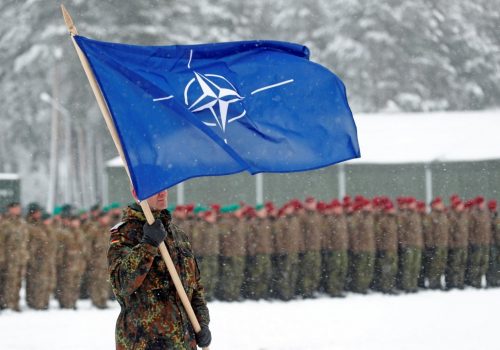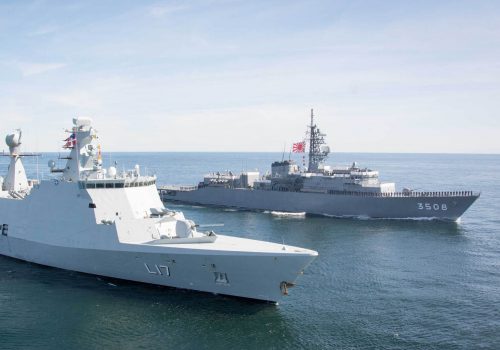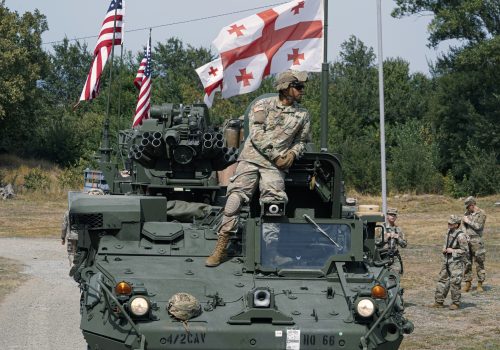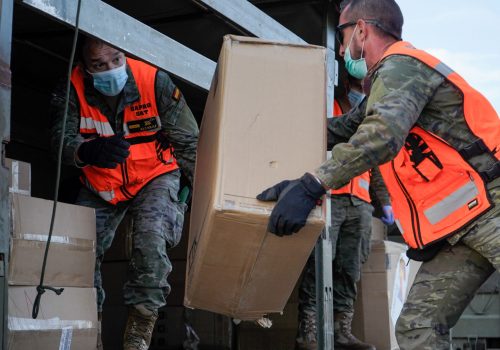Reimagine the Washington Treaty
A transatlantic alliance became a reality in 1949 only when the promise of the end of war was overshadowed by the threat of communism. The North Atlantic Treaty, also known as the Washington Treaty, was an effective answer to an inflection point in the history of the international order,1Dean Acheson, Present at the Creation: My Years in the State Department (New York: W.W. Norton and Company, 1969). founding an alliance that succeeded in safeguarding the free world.
More than seventy years later, the global system sits at another inflection point.2John F.W. Rogers and Frederick Kempe, Annual Report 2019/2020: Introduction, Atlantic Council, July 21, 2020, https://www.atlanticcouncil.org/in-depth-research-reports/report/annual-report-2019-2020introduction/ Increasing challenges from authoritarian regimes, namely Russia and China, combined with democratic erosion, abandonment of norms, and a dramatically changed geopolitical and technological landscape demand a reexamination of the only alliance capable of organizing free nations’ defense and guaranteeing their prosperity.
What would the Washington Treaty look like if it were written today? How should NATO meet today’s new and more complex geopolitical challenges while maintaining the elegant simplicity and flexibility of its founding treaty? In answering these questions, we propose four recommendations:
- Bolster NATO as an alliance of free, democratic states;
- Ensure NATO can compete in an era of geoeconomics by protecting allies’ economic security in the midst of rapid technological change and great power competition;
- Rebalance the transatlantic bargain and bolster NATO’s role as the forum for political consultation to ensure common strategies; and
- Put NATO at the center of a global network of democratic alliances and strategic partnerships.
This reimagined NATO would position the Alliance as the backbone of the free world. It can set us on a path to adapting the most successful alliance in history to ensure its relevance in the twenty-first century. It could also serve as the starting point for a new Strategic Concept to replace the outdated 2010 version.
NATO as an alliance of free nations
The Washington Treaty’s preamble underscores that freedom is at NATO’s core: the parties “are determined to safeguard the freedom, common heritage and civilization of their peoples, founded on the principles of democracy, individual liberty and the rule of law.” Article 2 commits NATO allies to “contribute toward the further development of peaceful and friendly international relations by strengthening their free institutions, by bringing about a better understanding of the principles upon which these institutions are founded…”
As Soviet occupation led to communism’s spread through Central and Eastern Europe, NATO became the anti-communist bulwark. It protected the independence of its members and their democratic way of life. While the founders of the Alliance pointed to democracy and free institutions as a basis for unity, it was the threat of communism’s expansion that held them close. During the Cold War, NATO accepted undemocratic developments in its members as long as they remained committed to anti-communism.
The fundamental geopolitical divide today is between free peoples and those who live under authoritarian regimes. As democracy erodes globally,3Larry Diamond, “Democracy’s Deepening Recession,” Atlantic, May 2, 2014, https://www.theatlantic.com/international/archive/2014/05/the-deepening-recession-of-democracy/361591/ a declining Russia has become revanchist, a rising China grows more confident, Iran remains aggressive, and North Korea continuingly bellicose. These regimes are the principal source of security threats to global democracies (excluding climate change). A divide manifests itself between allies and partners who seek to adapt, revitalize, and defend a rules-based international order, and revisionist powers who seek to bend those rules (China) or destroy them altogether (Russia).
In response, NATO should extol the freedom of its members—sovereignty of the nation combined with liberty of its citizens—as its defining attribute in the twenty-first century. Democracy, individual liberty, rule of law, and free institutions would form the explicit basis for what binds allies together. This reimagination would require allies to recommit to meeting democratic standards at home and to stand in solidarity in the face of authoritarian challenges to free peoples.
Watch the video
NATO in an era of geoeconomics
NATO’s founders understood the link between security and prosperity. They captured this in Article 2: Allies “will seek to eliminate conflict in their international economic policies and will encourage collaboration between any or all of them.” Informed by the lessons of post-World War I punitive economic policies, the Washington Treaty recognized the need to harness cooperation among former adversaries as well as the need for prosperity to ensure democracies could compete with emerging communist regimes.
NATO provided a security umbrella under which European nations could rebuild their economies by cooperating through the Marshall Plan, laying the basis for the process of European integration culminating in today’s European Union (EU). Yet, the economic dimensions of the Alliance remained narrowly focused on supporting military cooperation.
Today, competition with the free world’s adversaries, especially China, is primarily fought in the economic battlespace.4David H. McCormick, Charles E. Luftig, and James M. Cunningham, Economic Might, National Security, and the Future of American Statecraft, Atlantic Council, July 2020, https://www.atlanticcouncil.org/in-depth-research-reports/economic-might-national-security-and-the-future-of-american-statecraft/ The attractiveness of the democratic, free-market model is being challenged by state-directed, corrupt capitalism and the economic success of the Communist Party of China, which has delivered historic numbers of people out of poverty without granting them individual liberties. Many allies and NATO partners are increasingly dependent on imports and investment from China; economic dependence breeds political influence. Over time, China will represent the single most significant challenge to NATO allies. Some degree of economic interdependence is inevitable and beneficial. Yet, in this new era of geoeconomic competition, NATO must learn to compete.
Allies should reimagine their treaty to bring life to Article 2, developing the economic clause into a stand-alone article that binds them in a common strategy to ensure the success of free markets and provide for economic security. This would require a concerted strategy around ensuring security through coordinated international trade and investment policies, blending national security and economic interests. This mindset demands a much closer and structured NATO-EU relationship to align members’ policies around promoting the rule of law for free and fair trade, negotiating trade terms together with authoritarian regimes such as China, and developing compatible investment-screening regimes (see below).
With this approach, NATO would also step up its efforts to bolster the resilience of its members’ economies against cyber threats, ensure the security of telecommunications networks and critical transportation infrastructure, safeguard critical supply chains, boost energy independence, and help set standards for the use of artificial intelligence, quantum computing, and other new technologies.
NATO embodies a new transatlantic bargain
Article 3 commits the parties “separately and jointly, by means of continuous self-help and mutual aid” to “maintain and develop their individual and collective capacity to resist armed attack.” It reflects the concept of burden sharing within NATO and an understanding that members would be contributors, not only consumers, of security.
Through much of the Cold War, the United States was the undisputed security power within NATO. Today, the capabilities and the ambitions of NATO’s European members have grown significantly. In turn, the US political appetite and fiscal capacity to shoulder most of the Alliance’s security responsibilities is waning. NATO requires a modernized Article 3 that provides its European members more equal responsibilities and a more equal voice. While the premise should remain that the allies will act together, European allies should assume greater responsibility for security in their neighborhood, including through a modernized relationship with the EU.
This new transatlantic bargain should, however, go beyond capabilities and burden sharing to commit the parties to closer political consultation and the development of common strategies to address global challenges. Article 4 commits the allies to “consult together whenever, in the opinion of any of them, the territorial integrity, political independence or security of any of the Parties is threatened.” This requirement for consultation helped lead to the creation of the North Atlantic Council (NAC) as a venue for such political discussions.
While NATO developed habits of military cooperation among its members, the Alliance has atrophied as the primary venue for transatlantic consultation. Consultation is the key ingredient for forging a common view of issues, which is a prerequisite for developing comparable, if not common, strategies. Too often, allies limit the nature of what is discussed at the NAC to issues on which NATO has a direct role. This undermines the power of an alliance which is well suited to help allies develop common national approaches.
Accordingly, a reimagined treaty should ensure that NATO is a forum in which allies can consult and seek solutions for any major issue that has implications for allies, not specifically military ones or ones limited to Euro-Atlantic geography.
Accordingly, a reimagined treaty should ensure that NATO is a forum in which allies can consult and seek solutions for any major issue that has implications for allies, not specifically military ones or ones limited to Euro-Atlantic geography. Such consultation should not imply NATO action, rather it should demonstrate NATO as the default venue for transatlantic consultation. Ensuring NATO as the venue for political consultations, which should include the EU, will guarantee a NATO relevant to twenty-first-century challenges which are inherently global and require a broader conceptualization of security.
NATO at the center of a network of alliances
Article 10 allows allies “by unanimous agreement” to “invite any other European state in a position to further the principles of this Treaty and to contribute to the security of the North Atlantic area to accede to this Treaty.” NATO should remain committed to enlargement, helping to ensure a Europe whole, free, and at peace that includes new allies (who seek membership) in Scandinavia, the Western Balkans, and Europe’s east. At the same time, an adapted Article 10 or subsequent article should pave the way for NATO to go well beyond its current partnership tools to form “alliances with the Alliance,” a pathway that could be open to the EU, a democratic Russia, and non-European democratic states. This would put NATO at the center of a global network of alliances that would help ensure peace and security.
NATO has already developed an effective security network with partner nations and organizations. This is out of recognition that threats to its members can originate from anywhere, that NATO needs partners in its operations, and that allies benefit from regional expertise and advice to inform their own decision-making. Yet in today’s interconnected world, the scale of the challenge allies face is global. A reimagined NATO would open the door to formal alliances with leading democracies such as Japan, Australia, and, potentially, India.5George W. Bush, “Address by George W. Bush, President of the United States of America” in NATO Russia Council: Rome Summit 2002, 19, May 28, 2002, https://www.nato.int/docu/comm/2002/0205-rome/rome-eng.pdf Furthermore, this new clause could provide a pathway in the future for a democratic Russia, not to join NATO, but to forge an alliance with the Alliance.6Alexander Vershbow, Nick Burns, Dan Fried, and Dick Schifter, “Moving Toward NATO Expansion,” memorandum, Clinton Presidential Library, October 4, 1994, https://www.archives.gov/files/declassification/iscap/pdf/2016-140-doc05.pdf It could also provide for the strategic partnerships that NATO is building with other organizations, such as the African Union. The EU is a special case as it reflects the shared sovereignty of many European nations, most of which are NATO allies.
The task of completing a Europe whole, free, and at peace cannot be left to NATO or the EU alone. Rather, it requires a fundamentally different relationship between the two institutions. Any consideration of the North Atlantic region today demands that the Alliance of the future be more effective at safeguarding freedom and advancing security in Europe’s east and North Africa, the two areas of the transatlantic region most troubled by insecurity and instability. To do so requires a comprehensive approach in which transatlantic nations integrate NATO and EU approaches. To overcome the barriers to closer cooperation, a reimagined treaty should envision the EU as an ally and strategic partner that has a seat at the NAC table and delivers integrated strategies for NATO’s east and south.
Conclusion
The Washington Treaty has stood the test of time. Its simplicity has provided for the adaptations NATO needed to remain relevant to the challenges of different eras. Today, the Alliance is strained by transatlantic political tensions. The Trump administration’s approach is leading some allies to hedge against their reliance on the United States, making it risky to reopen the Washington Treaty.
In a scenario of renewed US leadership and a new allied consensus, however, adapting the treaty to the twenty-first century could be not only possible, but beneficial. Article 12 provides a pathway to review the treaty. Indeed, the treaty has been amended before.7Damon Wilson, Completing Europe: Georgia’s Path to NATO, Atlantic Council, February 27, 2014, https://www.atlanticcouncil.org/in-depth-research-reports/issue-brief/completing-europe-georgia-s-path-to-nato/ Membership for each nation that has joined the Alliance under Article 10 has required an amendment to the treaty in the form of accession protocols. While enlargement is not on the short-term agenda, by the time consensus emerges to deliver on the Bucharest Summit commitment to welcome Georgia and Ukraine into the Alliance, the allies may be in a position to coalesce around a modernization of the Washington Treaty to ensure it is as effective in this century as it was in the previous one.
The NATO of this reimagined Washington Treaty is an adaptable, multifaceted alliance that can address the political, economic, and security concerns of a new era by serving as the relationship of first resort for North America and Europe while simultaneously being the center of a global network of alliances of democratic nations. As the spine of the free world, NATO would be prepared for the generational threat of authoritarianism by employing all the capabilities of an expanded assembly of allied nations.
* * *
Damon Wilson is the executive vice president of the Atlantic Council. Follow him on Twitter @DamonMacWilson.
Will O’Brien is the executive assistant to the executive vice president of the Atlantic Council. Follow him on Twitter @WmThOBrien.
Explore the podcast series
Related NATO 20/2020 essays
Related program
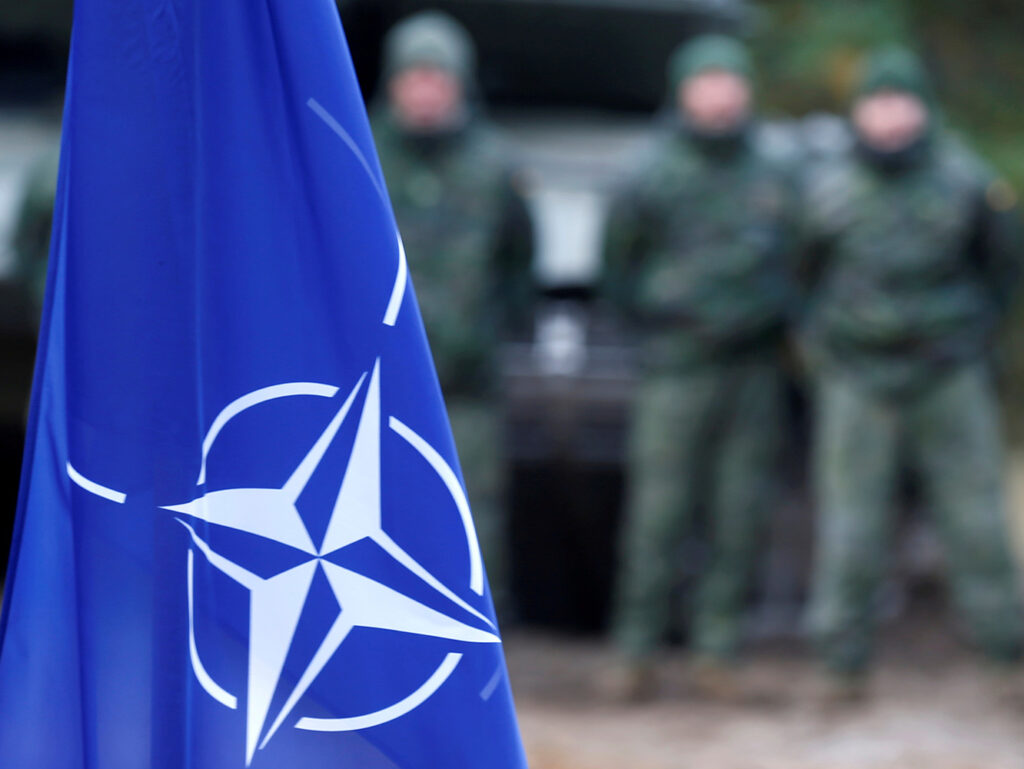
The Transatlantic Security Initiative, in the Scowcroft Center for Strategy and Security, shapes and influences the debate on the greatest security challenges facing the North Atlantic Alliance and its key partners.
Subscribe for events and publications on transatlantic security
Sign up for updates from the Atlantic Council’s Transatlantic Security Initiative, covering the debate on the greatest security challenges facing the North Atlantic Alliance and its key partners.
Image: Raising of the flags at the handover ceremony for the new NATO Headquarters in 2018 (Source: NATO Flickr)
